| Oscar
Sachs Oscar V. Sachs Júnior, 63 years old, comes from Araras, in the state of São Paulo. After attending the Social Sciences course at the University of São Paulo (he even became the president of the Guild and, in 1964, during the military regime in Brazil, he has been "counseled" not to show up any more at the university), he finished for being graduated in business administration. He have been working for 30 years at Volkswagen do Brasil, until be transferred to Taubaté, to help in the building of the new factory and where, now retired, he still lives, in a country house of 4000 m sq, with five jaboticaba trees (which he considers as his |
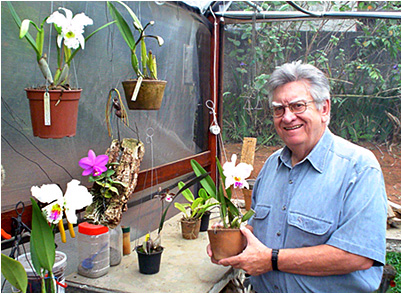 |
|
most value) and a piece of Atlantic forest, he insisted in preserving. Since almost 30 years ago, he cultivates orchids and stood out as an active member of CAOB (Coordination of the Brazilian Orchids Associations), in the edition of the bulletin and, now, in Brasil Orquídea magazine, publishing house with the same name, he founded in 2002 and maintains with the collaboration of some other editors. |
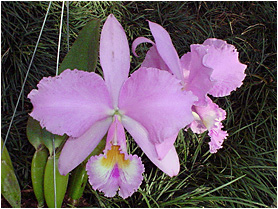 |
ON:
Why did you start to cultivate orchids? Which was the magic moment of
attraction? OS: Ah, you never know the moment the " little fly" stings you! When I lived in Santo André, I often met a great orchidist, Eugênio Santi, and, by this time, I found those flowers gorgeous but without too much enthusiasm. When I moved to Taubaté, I bought a house in down town with a big back yard and many trees where there were, blooming, some Dendrobium some Cattleya loddigesii, that I started to find interesting. So, me and my son Fábio, who was at about eight or nine years old, started to go to Serra do Mar and bring home (I not even knew the names) Maxillaria, Miltonia, we still have a picture |
from Fábio with a clump of Pabstia jugosa. We
put those plants in a luggage of car that the former resident left there,
under a Plumeria (Apocinaceae family). Then, I got from my uncle Afonso Schmidt a Cattleya warneri and a Laelia purpurata. Thus, every thing started. ON: How long do you cultivate orchids? OS: Well... It happened at about 75 or 76, so I am close to 30 years of orchidophilia. Nowadays, of course, I do not pick up anything from the nature not even a grass, I am ferocious partisan of the preservation of the woods and environment. |
ON:
How many plants do you have, approximately? OS: I think it is at about a thousand and half. I have a green-house covered with plastic, with sprinkling system of water, where I cultivate my South American Cattleya, nobilior and loddigesii, some special laelia, |
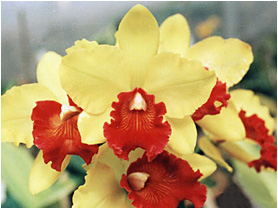 |
such
as perrinii, lobata, alaorii,
on one side and in another, a rank of hybrids. Lower, there is the P1, a definitive temporary (my wife believed it is temporary, she is a saint...), just covered with shade cloche , included the sides where I keep the purpurata and walkeriana, which love rain any way, |
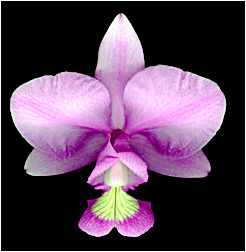 |
and
the P2, another temporary, where I keep the labiata and warneri. I also
have many trees, with established or hanging plants, what I call “miscellaneous”,
there are Dendrobium, Mexican Laelia, Coelogyne, Maxillaria, Oncidium,
Miltonia, many plants. Oh! God, a heap of plants! |
ON:
Do you prefer hybrids or species? Why? OS: I don't see any dichotomy between hybrids and species; I love orchids. First, I had a certain prejudice against hybrids, but, meeting Tajima and Sérgio Barani, I found that there is much beauty between the orchids produced by the man. Sometimes ago, I heard from Dr. Ronaldo, from Batatais, a great friend of mine, that he loves hybrids provide they are beautiful. So do I. |
| ON: Among yours, do
you have a favorite plant? OS: My first enchantment was with the purpurata, influenced, may be, by Heitor Gloeden and Walter Filippetti (God, how I miss those old friends!). |
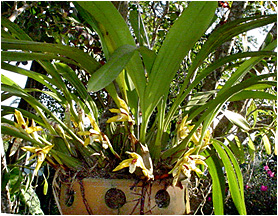 |
Then
I overcame the famous phase where we want everything, buy everything,
no preferences or criterion. I think that the evolution of an orchidist
is getting the Cattleyas from Venezuela and Colombia, always fantastic
and also know how to appreciate the delicacy of micro-orchids, of Bulbophyllum,
Zygopetalum, Catasetum, Trigonidium. Funny, I've never loved Phalaenopsis nor Cattleya intermedia (a dangerous statement, in front of so many de fanatics. I can even suffer an attack ... ). I have an attraction for Maxillaria, about what I have already written an article to Orquidário magazine and still today produces commentaries. No, nowadays, I do not have an exclusively preference. |
ON: How long do you spend taking care of your orchids daily? OS: Ah, not too much. In general, in the morning, at about half an hour, an hour and sometimes, more. At this moment, I need to tell my secret, the help I get from Maneco, my faithful squire and gardner of the country house. The famous Maneco, already known by the orchidists in Taubaté, who helps me to repot the orchids and fight against the plagues. He is a special "idle talk ”. It is delightful hearing him with his heavy accent. ON: Which are the climate conditions in your place? OS: Taubaté is placed at about 550 m s.n.m., between Mantiqueira and Serra do Mar. We have a lot of rain, heat and a good cool period when the grass dries up completely. Because of the proximity of the wood, I have fungal infections, “leaf miner ” (the fly that lets a small larva and makes a tunnel in the leaves) and, mainly, the great plague of the Paraíba Valley: The ants which bring mealybus and another evil been (for the orchids because they are there, living their lives). With a closed green house (with nets at the sides) things get better. I avoid, for example, the winter rains because after that there was always an infestation any how. |
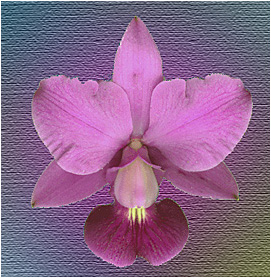 |
ON:
Do you have a cultivation tip to share with us? OS: The best tip is to the beginners is to observe well and observe a lot. That is why is so important to participate (or attend) the orchids shows, meetings at the associations, see the substrates, how the plants have been poted, what kind of pots, fertilizers, talking a lot with the orchids growers with a good cultivation, with the sellers (those who are honest and experienced because there are some that I never buy even a second hand car), read every thing about orchids (I think that I have, today, one of the good library specialized in orchids, in Brazil, read everything you should about orchids orquídeas and Brasil Orquídeas (ops, look the advertisement!). |
ON:
Besides that first attraction, was there any influence (people or fact)
regarding your relationship with orchids? OS: I have been influenced, as already said, by: Heitor Gloeden, to whom I often paid visit in the country house Cuietê; Filippetti, with whom, sometimes I ate a macaroni and drank wine; my old friend and companion Nilo Bueno Patrício; Luiz Celloto; Sidnei Resende; Zé Roberto Marques; Cava Cano; the Wenzel... a heap of people. More recently, I learnt a lot with Tajima, Barani, Roland, Patto, Epiphanio, Ronaldo Nazar, Egel, Luiz Roberto Jordão, just nice people. My best teacher, nowadays is Marquinhos Campacci. For sure, I forget someone. ON: Is there a short or an amusing story connected to orchids you can tell us? OS: Not exactly with orchids, but with orchidophilia. I think I have already told this story. Once I was in Franca, in a orchid show and some people from CAOB, César Wenzel ahead, were distributing CAOB Newspaper. I told him and Zé Roberto that I had two evaluations: first class for the initiative - wonderful, there was a lack of communication between the orchidists - and zero for content - a rubbish, only copied, only second handmaterial, reproduction, why didn't they do an original thing, even if it was precarious? They looked each other and kept away, a few minutes later, they surrounded me and gave me an ultimatum: We want you making the Caob Newspaper! I couldn't refused, a manager I became a journalist. I did the Newspaper and soon I started to do Caob Magazine and I never stopped. Today, I am the editor of the best magazine about orchids in Brazil, Brasil Orquídeas (ops, advertisement again!). Everything started because I because I talk too much in Franca, what a big mouth! |
|
ON:
One said that orchidophilia a soft manifestation of madness. Have you
done any "orchidophilic" insanity?
OS: Yes. I have already spent more money than I could buying plants. I have already driven from Piracanjuba until Taubaté non-stop; I have already picked up plants in the wood (no more); I have already picked a quarrel because of orchidophilia (what a stupidity because this is for fun); I became furious because my plants were underestimated (nowadays, “I don't care less”), I don't know... I should have other sins, I hope venial sins all of them. The great advantage of the orchidophilia is the huge number of friends, great friends, we make. It's worth everything. |
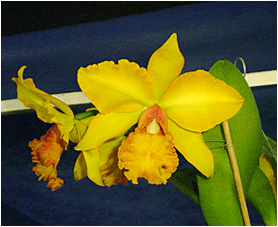 |
